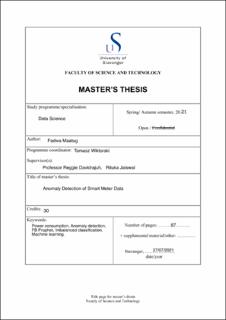| dc.description.abstract | Presently, households and buildings use almost one-third of total energy consumption among all the power consumption sources. This trend is continuing to rise as more and more buildings install smart meter sensors and connect to the Smart Grid. Smart Grid uses sensors and ICT technologies to achieve an uninterrupted power supply and minimize power wastage. Abnormalities in sensors and faults lead to power wastage. Along with that studying the consumption pattern of a building can lead to a substantial reduction in power wastage which can save millions of dollars. According to studies, 20\% of energy consumed by buildings are wasted due to the above factors. In this work, we propose an anomaly detection approach for detecting anomalies in the power consumption of smart meter data from an open dataset of 10 houses from Ausgrid Corporation Australia.
Since the power consumption may be affected by various factors such as weather conditions during the year, it was necessary to search for a way to discover the anomalies, considering seasonal periods such as weather seasons, day/night and holidays. Consequently, the first part of this thesis is to identify the outliers and obtain data with labels (normal or anomalous). We use Facebook prophet algorithm along with power consumption domain knowledge to detect anomalies for two years of half-hour sampled data.
After generating the dataset with anomaly labels, we proposed a method to classify future power consumptions as anomalous or normal. We use four different approaches using machine learning for classifying anomalies. We also measure the run-time of different classification algorithms. We are able to achieve a G-mean score of 97 per cent. | |
